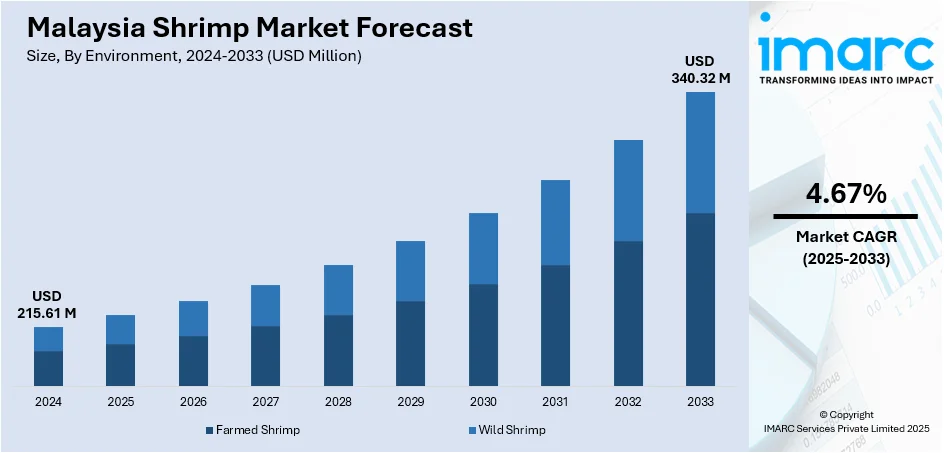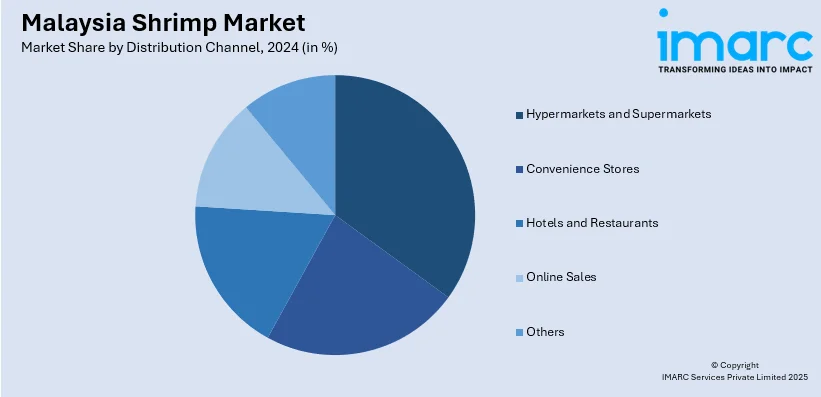
Malaysia Shrimp Market Size, Share, Trends and Forecast by Environment, Species, Shrimp Size, Distribution Channel, and States, 2025-2033
Malaysia Shrimp Market Overview:
The Malaysia shrimp market size reached USD 215.61 Million in 2024. The market is projected to reach USD 340.32 Million by 2033, exhibiting a growth rate (CAGR) of 4.67% during 2025-2033. The market is expanding due to steady domestic consumption and wider export links. In addition, stronger hatchery practices and eco-friendly farming methods continue to support Malaysia shrimp market share across local food supply chains and international seafood trade channels.
|
Report Attribute
|
Key Statistics
|
|---|---|
|
Base Year
|
2024
|
|
Forecast Years
|
2025-2033
|
|
Historical Years
|
2019-2024
|
| Market Size in 2024 | USD 215.61 Million |
| Market Forecast in 2033 | USD 340.32 Million |
| Market Growth Rate 2025-2033 | 4.67% |
Malaysia Shrimp Market Trends:
Domestic Demand and Export Reach
Steady local and overseas demand continues to drive Malaysia shrimp market growth as more households choose shrimp for daily meals and festive gatherings. The food service sector adds to this, with restaurants and hotels relying on a steady supply of quality shrimp year-round. On the export front, Malaysia is working to expand its share in nearby markets such as Japan, Singapore, and China. To do this, producers have been modernizing hatcheries, improving feed methods, and investing in better water controls to meet tight safety standards. New measures include stronger checks for disease and better pond management to reduce sudden losses. Many coastal farmers have joined forces in cooperatives, which helps them buy feed and equipment at lower costs and sell larger volumes under unified contracts. The government has backed cold chain improvements that keep shrimp fresher during transport to cities and ports. Community training programs have also encouraged small-scale farmers to upgrade their ponds and learn safer farming practices. All these improvements help Malaysia remain a trusted source of shrimp, giving farmers more confidence to grow their businesses and supply both local and foreign buyers consistently.

To get more information on this market, Request Sample
Sustainable Methods Gain More Ground
Shrimp farming in Malaysia is seeing a steady shift toward greener practices as farmers look for ways to keep ponds productive without harming local waterways. Many are exploring ways to reuse water, install lined ponds to control seepage, and use feeds that reduce waste. Government-backed pilot farms have shown that using natural bacteria and plant-based additives keeps shrimp healthy without relying on harsh treatments. Some larger producers are working to get eco-label certifications that show their shrimp meets international sustainability standards, opening doors to higher-paying export deals. Universities have partnered with farms on breeding work that produces stronger shrimp that need fewer antibiotics. Small groups in coastal areas are planting mangroves along pond edges to help absorb runoff and protect shorelines from erosion. These steps not only protect local habitats but also add credibility when marketing Malaysian shrimp to buyers who value cleaner, responsibly raised seafood. This move toward lower-impact production methods is helping farmers build more secure businesses that can keep producing year after year, ensuring steady incomes for communities that depend on shrimp as a major source of livelihood.
Malaysia Shrimp Market Segmentation:
IMARC Group provides an analysis of the key trends in each segment of the market, along with forecasts at the country and regional level for 2025-2033. Our report has categorized the market based on environment, species, shrimp size, and distribution channel.
Environment Insights:
- Farmed Shrimp
- Wild Shrimp
The report has provided a detailed breakup and analysis of the market based on the environment. This includes farmed shrimp and wild shrimp.
Species Insights:
- Penaeus Vannamei
- Penaeus Monodon
- Macrobrachium Rosenbergii
- Others
The report has provided a detailed breakup and analysis of the market based on the species. This includes penaeus vannamei, penaeus monodon, macrobrachium rosenbergii, and others.
Shrimp Size Insights:
- <21
- 21-25
- 26-30
- 31-40
- 41-50
- 51-60
- 61-70
- >70
The report has provided a detailed breakup and analysis of the market based on the shrimp size. This includes <21, 21-25, 26-30, 31-40, 41-50, 51-60, 61-70, and >70.
Distribution Channel Insights:

- Hypermarkets and Supermarkets
- Convenience Stores
- Hotels and Restaurants
- Online Sales
- Others
A detailed breakup and analysis of the market based on the distribution channel have also been provided in the report. This includes hypermarkets and supermarkets, convenience stores, hotels and restaurants, online sales, and others.
States Insights:
- Selangor
- W.P. Kuala Lumpur
- Johor
- Sarawak
- Others
The report has also provided a comprehensive analysis of all the major states markets, which include Selangor, W.P. Kuala Lumpur, Johor, Sarawak, and others.
Competitive Landscape:
The market research report has also provided a comprehensive analysis of the competitive landscape. Competitive analysis such as market structure, key player positioning, top winning strategies, competitive dashboard, and company evaluation quadrant has been covered in the report. Also, detailed profiles of all major companies have been provided.
Malaysia Shrimp Market News:
- March 2025: UKRI launched a £12 Million program supporting sustainable shrimp farming in Malaysia through research partnerships. This funding backed low-cost tools, better hatchery methods, and climate solutions, helping small farmers strengthen biosecurity, manage disease risks, and boost Malaysia’s shrimp production efficiency.
Malaysia Shrimp Market Report Coverage:
| Report Features | Details |
|---|---|
| Base Year of the Analysis | 2024 |
| Historical Period | 2019-2024 |
| Forecast Period | 2025-2033 |
| Units | Million USD |
| Scope of the Report |
Exploration of Historical Trends and Market Outlook, Industry Catalysts and Challenges, Segment-Wise Historical and Future Market Assessment:
|
| Environments Covered | Farmed Shrimp, Wild Shrimp |
| Species Covered | Penaeus Vannamei, Penaeus Monodon, Macrobrachium Rosenbergii, Others |
| Shrimp Sizes Covered | <21, 21-25, 26-30, 31-40, 41-50, 51-60, 61-70, >70 |
| Distribution Channels Covered | Hypermarkets and Supermarkets, Convenience Stores, Hotels and Restaurants, Online Sales, Others |
| States Covered | Selangor, W.P. Kuala Lumpur, Johor, Sarawak, Others |
| Customization Scope | 10% Free Customization |
| Post-Sale Analyst Support | 10-12 Weeks |
| Delivery Format | PDF and Excel through Email (We can also provide the editable version of the report in PPT/Word format on special request) |
Key Questions Answered in This Report:
- How has the Malaysia shrimp market performed so far and how will it perform in the coming years?
- What is the breakup of the Malaysia shrimp market on the basis of environment?
- What is the breakup of the Malaysia shrimp market on the basis of species?
- What is the breakup of the Malaysia shrimp market on the basis of shrimp size?
- What is the breakup of the Malaysia shrimp market on the basis of distribution channel?
- What is the breakup of the Malaysia shrimp market on the basis of states?
- What are the various stages in the value chain of the Malaysia shrimp market?
- What are the key driving factors and challenges in the Malaysia shrimp market?
- What is the structure of the Malaysia shrimp market and who are the key players?
- What is the degree of competition in the Malaysia shrimp market?
Key Benefits for Stakeholders:
- IMARC’s industry report offers a comprehensive quantitative analysis of various market segments, historical and current market trends, market forecasts, and dynamics of the Malaysia shrimp market from 2019-2033.
- The research report provides the latest information on the market drivers, challenges, and opportunities in the Malaysia shrimp market.
- Porter's Five Forces analysis assists stakeholders in assessing the impact of new entrants, competitive rivalry, supplier power, buyer power, and the threat of substitution. It helps stakeholders to analyze the level of competition within the Malaysia shrimp industry and its attractiveness.
- Competitive landscape allows stakeholders to understand their competitive environment and provides an insight into the current positions of key players in the market.
Need more help?
- Speak to our experienced analysts for insights on the current market scenarios.
- Include additional segments and countries to customize the report as per your requirement.
- Gain an unparalleled competitive advantage in your domain by understanding how to utilize the report and positively impacting your operations and revenue.
- For further assistance, please connect with our analysts.
 Request Customization
Request Customization
 Speak to an Analyst
Speak to an Analyst
 Request Brochure
Request Brochure
 Inquire Before Buying
Inquire Before Buying




.webp)




.webp)












